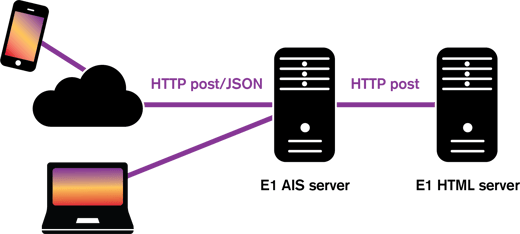Search for topics or resources
Enter your search below and hit enter or click the search icon.
February 25th, 2020
2 min read
By Eric Poff

If you're a JD Edwards (JDE) user, you know you can't click on a post, log in to webinar or walk into a user group meeting without hearing two words: AIS and Orchestrator. Still, you're not alone if you can't define the bond they share or why you should care. Welcome to part one in an 8-part series designed to answer all of your questions. Each week you'll find real-world explanations and illustrations from industry experts beginning with the connection between the AIS server and Orchestrator in JDE.
To understand JDE Orchestrator Studio, start with AIS — Application Interface Services. Oracle introduced AIS in Tools 9.1.4.2 as the technical foundation for exposing JD Edwards applications and data as a RESTful API. Think of it as an additional "server" in your JD Edwards architecture.
An AIS instance is configured upon installation to communicate with a specific HTML instance. It might look a little like this:

Now that you know what it is, what can you do with it? At ERP Suites, our development principle is this: if a JDE user can perform an action in the JDE HTML client, then we can programmatically do the same with an AIS server. It's an important concept that leads us directly to orchestration.
First, let me explain what the term orchestration means. In the early days of software development, applications were monolithic. In other words, they were written with all functions tightly integrated to work as a single unit. Cohesion is usually positive, but in this case, it meant applications were difficult to scale and costly to maintain.
Enter microservices. The microservices approach broke down applications into independent services that could perform as one function. Application developers could then organize multiple services around business capabilities — this is orchestration.
For example:
Imagine your business requested a graphical user interface (GUI) to display customer locations. Taking a microservices approach, you first create a service to retrieve a customer's physical address from the CRM system. Next, you leverage a web service to translate the address from city, state, and ZIP into latitude and longitude. Finally, you use a mapping service to display the latitude and longitude on a map. The act of coordinating all three services to work together is orchestration.
This same philosophy applies to JDE Orchestrator Studio. Orchestrator is a web-based development tool for creating applications that execute services. The services can be JD Edwards modules (exposed via AIS), file transfer services, or even third-party web services. Orchestrations are developed to represent business processes and are made available as endpoints. Then, you can call the endpoints over HTTP(S).
While JSON and REST calls may seem trivial, Orchestrator Studio hides many of the real complexities of AIS. Just about all of the capabilities of a JDE application are exposed in a GUI. For example, you can interact with the Row and Form exit functions in the P4210 Sales Order Entry program.
By simplifying development, Orchestrator empowers non-traditional JDE users to create solutions that address business challenges. At the same time, more experienced users can automate multi-step complex business processes. Orchestrator Studio can also expose JDE to external systems and applications in a secure and relatively easy manner.
Now that you understand the relationship between the AIS server in JDE and Orchestrator begin thinking about the ways you can use them to reduce steps, automate data entry, or integrate third-party products. These can ultimately save time, reduce errors, and support sales growth. In our next blog, we'll explore how to use Orchestrator to export data with practical examples from ERP Suites customers.
Need help getting started? Click to learn about our Orchestrator Services. ERP Suites is a JD Edwards Gold Partner and winner of the 2019 Oracle Distinguished Partner Award for Successful Adoption of Orchestrator.
As the Chief Advisory Officer at ERP Suites, Eric Poff sits on the leading edge of digital technology. Customers lean on him to drive meaningful process improvement with measurable results. His product development and work with Orchestrator have earned ERP Suites several JD Edwards Distinguished Partner Awards. He is also a frequent conference presenter dedicated to bringing digital transformation within reach.
Topics: